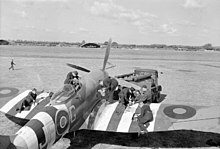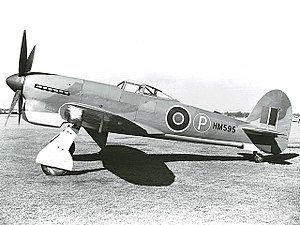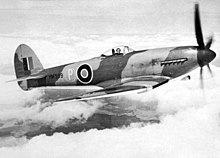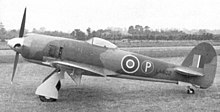| Tempest | |
|---|---|
| Tempest V prototype HM595 | |
| Role | Fighter/Bomber |
| Manufacturer | Hawker Aircraft Limited |
| Designed by | Sydney Camm |
| First flight | 2 September 1942 |
| Introduced | January 1944 |
| Status | Retired |
| Primary user | Royal Air Force |
| Number built | 1,702 |
| Developed from | Hawker Typhoon |
| Variants | Hawker Sea Fury |
Contents
|
Design and development
During development of the Typhoon the design team, under the leadership of Sydney Camm, were already planning design improvements, this process resulting in the Hawker P. 1012 (or Typhoon II).[1]Although the Typhoon was basically a good design, Camm and his design team were disappointed with the wing which proved to be too thick in its cross section; this created problems with the airflow and inhibited the performance of the aircraft, especially at higher altitudes. The Typhoon's wing, using a NACA 4 digit series wing section, had a maximum thickness to chord ratio of 19.5% (root) to 12% (tip).[2] In March 1940, engineers were assigned to investigate the new low drag laminar flow wing developed by NACA in the United States, which had been used in the new North American P-51 Mustang. A laminar flow wing adopted for the Tempest series had a maximum thickness to chord ratio of 14.5% at the root, tapering to 10% at the tip.[2] The maximum thickness of the Tempest wing was set further back at 37.5% of the chord versus 30% for the Typhoon's wing.[2]
The wingspan was originally greater than that of the Typhoon at 43 ft (13.1 m), but the wingtips were later "clipped" and the wing became shorter; 41 ft (12.5 m) versus 41 ft 7 in (12.7 m). The wing planform was changed to an elliptical shape to accommodate the 800 rounds of ammunition for the four 20 mm (.79 in) Hispano cannons, which were moved back further into the wing. The new elliptical wing had greater area than the Typhoon's.[nb 1]
However, the new wing design sacrificed the leading edge fuel tanks of the Typhoon; to make up for this loss in capacity, Hawker engineers added a new 21 in (53 cm) fuel bay in front of the cockpit, with a 76 gal (345 l) fuel tank.[2] In addition, two inter-spar wing tanks, each of 28 gal (127 l), were fitted on either side of the centre-section and, starting with late model Tempest Vs, a 30 gal (136 l) tank was carried in the leading edge of the port wingroot, giving the Tempest a total internal fuel capacity of 162 gal (736 l).[3] In service Tempests also carried two specially designed, streamlined, drop-tanks of 45 gal (204 l) giving a maximum of 360 gal (1,636 l) and an operational radius of 500 mi (805 km)[4]
Another important feature of the new wing was Camm's proposal that radiators for the new Napier Sabre IV engine were to be fitted into the leading edge of the wing inboard of the undercarriage. This eliminated the distinctive "chin" radiator associated with the Typhoon and improved aerodynamics.[2]
A further improvement of the Tempest wing over that of the Typhoon was the exceptional, flush riveted surface finish, essential on a high performance laminar flow airfoil.[5] Fortunately for the pilots the new wing and airfoil, and the four-bladed propeller unit, eliminated the high frequency vibrations that had plagued the Typhoon.[6]
The redesigned main undercarriage legs were longer and had a wider track (16 ft/5 m) to improve stability at the high landing speed of 110 mph (180 km/h), and to allow tip clearance for a new de Havilland four-blade, 14 ft (4 m) diameter propeller. The main undercarriage units were designed to incorporate a system of trunnions which shortened the legs as they retracted.[7] The main wheels also needed new thin tyres in order to fit within the wing. Finally, the retractable tailwheel was fully enclosed by small doors.
The new design was finalised by October 1941 and the Air Ministry issued specification F.10/41 that had been written to fit the aircraft. A contract for two initial prototypes was issued the next month. The aircraft was originally named the "Typhoon Mark II" but was renamed "Tempest" in January 1942 when more prototypes with various experimental configurations were ordered.[2] The problems experienced with delivery of engines led the Air Ministry to ask for six prototypes with different engines so that if a delay hit one engine an alternative would be available. This gave the Mk I (aircraft HM599) with a Sabre IV, two Mk IIs (LA602 and LA607) with the Centaurus IV, MK III (LA610) with a Griffon IIB, Mk IV (LA614) with a Griffon 61 and the Mk V (HM595) with the Sabre II.[8]
The first Tempest prototype, the Mark V, was first flown by Philip Lucas from Langley on 2 September 1942. This aircraft retained the Typhoon's framed canopy, automobile-style door, the Sabre II engine, and "chin" radiator.[8] It was quickly fitted with a bubble canopy like the later Typhoons and a modified tailfin that almost doubled the vertical tail surface area. The horizontal tailplanes and elevators were also increased in span and chord (these were also fitted to late production Typhoons.)[8]
Continual problems with the Sabre IV meant that only one Mark I (HM599) was built; consequently Hawker went into production with the Sabre II engined "Tempest V". The first rolled off the production line on 21 June 1943.[10] The first Tempest Vs delivered had the long-barrelled 20 mm (.79 in) Hispano Mk II cannon. Later production aircraft used the short-barrelled 20 mm (.79 in) Hispano Mk V cannon, eliminating the protruding barrels—though these had not been as prominent as on the Typhoon.
The ultimate offshoot of the Typhoon and Tempest family was the Fury/Sea Fury.
Tempest Mark V
During production of the first batch of 100 (JNxxx serialled) Tempest Vs changes were progressively introduced:[nb 2]
The rear fuselage fuselage/empennage joint originally featured the 20 external reinforcing "fishplates" first seen fitted to the Typhoon. Sometime during this production batch the rear fuselage was modified and became detachable.[14] The first Tempest Vs used long barrelled 20 mm (.79 in) Hispano Mk. IIs which projected ahead of the wing leading edges. These were later replaced by short barrelled Mk. Vs which were flush with the leading edges. "Five spoke" wheels, of a similar pattern to those of the Typhoon, were later replaced by a reinforced "four spoke" pattern.
Initially, Tempest Vs used a built-up rear spar pick-up/bulkhead assembly (just behind the cockpit) which was adapted from the Typhoon. Small blisters on the upper rear wing root fairing covered the securing bolts. This was later changed to a new forged, lightweight assembly which connected to new spar booms: the upper wing root blisters were replaced by small "teardrop" fairings under the wings.[14] The new spar structure also allowed the wings to carry up to 2,000 lb (907 kg) of external stores. Also developed specifically for the Tempest by Hawker was a streamlined 45 gal (205 l) "drop tank" and carrier fairing; the redesigned wing incorporated the plumbing for these tanks, one to each wing.[10] The ailerons were fitted with spring loaded tabs which lightened the aerodynamic loads, making them easier for the pilot to use and dramatically improving the roll rate above 250 mph (402 km/h).[10] Different models of the Sabre II were introduced. The later versions were capable of producing over 2,400 hp (1,789 kW) on emergency boost for short periods of time.[12]
As in all mass-produced aircraft, there may have been some overlap of these features as new components became available. In mid to late 1944 other features were introduced to both the Typhoon and Tempest: A Rebecca transponder unit was fitted, with the associated aerial appearing under the portside centre section. A small, elongated oval static port appeared on the rear starboard fuselage, just above the red centre spot. This was apparently used to more accurately measure the aircraft's altitude.
Unusually, in spite of the Tempest V being the RAF's best low to medium altitude fighter, it was not equipped with the new Mk IIC gyroscopic gunsight, an asset which was fitted in RAF Spitfires and Mustangs from mid-1944 and one which considerably improved the chances of shooting down opposing aircraft. Tempest pilots continued to use the Mk.IIL reflector gunsight until just after World War II, when the gyro-gunsight was introduced in Tempest IIs.
In December 1943, the US Army Air Forces Materiel Command tested the Tempest V JN729 and concluded with: The Tempest should prove to be a very excellent fighter airplane. It is easy to fly and exhibits very desirable fighter characteristics coupled with excellent performance.[12]
Externally the Tempest V bore a strong resemblance to the Typhoon: the longer nose, thinner wings and larger tail unit, with a gracefully curved dorsal fin, enhanced the looks of the fighter, and were the most noticeable differences.
Two Tempest Vs, EJ518 and NV768, were fitted with Napier Sabre Vs and experimented with several different Napier made annular radiators, with which they resembled Tempest IIs. This configuration proved to generate less drag than the standard "chin" radiator, contributing to an improvement in the maximum speed of some 11 to 14 mph.[15] NV768 was later fitted with a ducted spinner, similar to that fitted to the Fw 190 V1.[9][16]
Another experimental Tempest V was SN345, which was fitted with two Vickers 47 mm "P" guns, one under each wing in a long "pod".[17][nb 3]
Tempest II
The decision to drop the Hawker Tornado allowed Sydney Camm and his design team to transfer the alternative engine proposals for the Tornado to the more advanced Typhoon II (later to be renamed "Tempest"). As a result the Tempest was designed from the outset to use the Bristol Centaurus 18 cylinder radial engine as an alternative to the liquid cooled engines which were also proposed. Two Centaurus powered Tempest Mk II prototypes were to be built.[19]The first Tempest Mark II, LA602, flew on 28 June 1943 powered by a Centaurus IV (2,520 hp/1,879 kW) driving a four-blade propeller. LA602 initially flew with a Typhoon-type fin and rudder unit. This was followed by the second, LA607, which first flew on 18 September 1943 and was assigned to engine development. Apart from the new engine and cowling, the Tempest II prototypes were similar to early series Tempest Vs. The main airframe difference was the addition of carburettor air intakes in the inner leading edges of both wings, with an oil cooler and air intake in the inner, starboard wing.
The radial engine installation owed much to examinations of a captured Focke-Wulf Fw 190, and was unprecedentedly clean and effective. One adopted feature was the use of individual exhaust stubs, laid out in a row down either side of the fuselage, rather than the front collector and large single exhaust used by the Centaurus powered Tornado. In spite of the promise of a more reliable powerplant than the Sabre, there were frustrating problems, including overheating, unreliable and leaking exhausts, insufficient crankshaft lubrication and propeller reduction gear seizures. There were also problems with vibration, but they were fixed by replacing the original "rigid" eight-point engine mounts with six-point rubber-packed shock mounts. In a further attempt to alleviate engine vibration, the four blade propeller was replaced with a five blade unit; eventually, a finely balanced four bladed unit was settled on.[20]
Physically, the Tempest II was longer than the Tempest V (34 ft 5 in/10.5 m versus 33 ft 8 in/10.3 m) and 3 in (76 mm) lower. The weight of the heavier Centaurus engine (2,695 lb/1,222 kg versus 2,360 lb/1,070 kg) was offset by the absence of a heavy radiator unit, so that the Tempest II was only some 20 lb (9 kg) heavier overall. Performance was improved; maximum speed was 442 mph (711 km/h) at 15,200 ft (4,633 m) and climb rate to the same altitude took four and a half minutes compared with five minutes for the Tempest V. The service ceiling was increased to 37,500 ft (11,430 m)[4]
The Centaurus was generally regarded as superior to the Sabre, particularly in terms of reliability, and the engine and Tempest airframe proved an excellent match. The combination looked so promising that a contract for 500 of the type was placed as far back as September 1942, but Gloster was overloaded with production of the Typhoon and development of the Gloster Meteor, and the company could not handle the additional load.
In 1943, the Tempest Mark II production contract was allocated to Bristol, and the switch delayed production even more. The first Tempest II was rolled off the line on 4 October 1944. With the end of the Second World War in sight, orders for the Tempest II were trimmed or cancelled; after 50 Tempest IIs had been built at Bristol's Banwell facility, production was stopped and shifted back to Hawker.
A total of 452 Tempest IIs were built, including 136 basic Mark IIs and 316 "Fighter Bomber Mark IIs" (FB II). They were built mostly by Hawker and generally with Centaurus V engines, and of that number, 300 were completed after the war. The Tempest II, despite its slightly improved performance and better reliability, never saw combat.
Tempest IIs produced during the war were intended for combat against Japan, and would have formed part of a proposed British Commonwealth long range bomber force based on Okinawa, Tiger Force.[21] The Pacific War ended before they could be deployed.
The RAF passed 89 Tempest FB IIs to the Indian Air Force in 1947, while another 24 were passed on to the Pakistani Air Force.
Tempest VI
Various engineering refinements that had gone into the Tempest II were incorporated into the last Tempest variant, the "Tempest VI", which was fitted with a Napier Sabre V engine with 2,340 hp (1,700 kW). The more powerful Sabre V required a bigger radiator which displaced the oil cooler and carburettor air intake from the radiator's centre. Air for the carburettor was drawn through intakes on the leading edge of the inner wings, with the oil cooler being fitted behind the radiator. Most Tempest VIs were tropicalised with an air filter fitted in a fairing on the lower centre-section. Hundreds of Tempest VIs were ordered, though only 142 were built. The last piston-engined fighter in RAF service was a Tempest VI.For a long time it was thought that there were Tempest VIs converted for target towing: none of the service histories of the aircraft show TT conversions and no supporting photographic evidence has been found.
Drawing board designs
In 1944, in response to F.13/44 Sydney Camm started a design, the P.1027, for a slightly enlarged Tempest powered by a Rolls Royce R.46, which was projected to develop around 2,500–4,000 hp (1,864–2,983 kW). This engine would have driven eight-blade contra-rotating propellers. The radiator was to be moved into a ventral bath under the rear fuselage and wing centre section: the wingspan was 41 ft (12.5 m) and the length was 37 ft 3 in (11.4 m). The design was soon dropped in favour of the P.1030, which featured wing leading edge radiators and larger overall dimensions of 42 ft (12.8 m) wingspan and 39 ft 9 in (12.1 m) long. Top speed was expected to be in the region of 508 mph (817 km/h), with a rate of climb of 6,400 ft/min (1,951 m/min). Service ceiling was projected to be 42,000 ft (12,802 m).[22]Both tenders were dropped when Camm decided to follow the more promising jet engine designs he was working on.
Service history
Tempest V in combat

Early production Tempest V of 486 Sqn. April 1944. JN766 still has factory applied black and white Typhoon style underwing recognition bands (see "Invasion stripes").
Most of the operations carried out by 150 Wing comprised high altitude fighter sweeps, offensive operations known as "Rangers" (long-range sorties inside enemy territory, specifically to attack ground vehicles) and anti-shipping reconnaissance. In June 1944, however, the first German V-1 flying bombs were launched against London and the Tempest's excellent low-altitude performance made it one of the preferred tools for dealing with the small fast-flying unmanned missiles. 150 Wing was transferred back to the ADGB, where the Tempest squadrons racked up a considerable percentage of the total RAF kills over the flying bombs (638 of a total of 1,846 destroyed by aircraft).

Early Tempest V of 3 Sqn. at Newchurch. Note Invasion stripes painted on by the ground crew; the longer cannon barrels can be seen on the port-side wing.
The Tempest's primary role was to carry out "armed reconnaissance" operations deep behind enemy the front lines. The Tempest was particularly well suited to the role because of its high speed at low to medium altitudes, its long range when equipped with two 45 gallon drop tanks, the good firepower of the four 20mm cannon and the good pilot visibility.[26] Armed reconnaissance missions were usually flown by two sections (eight aircraft), flying in Finger-four formations, which would cross the front-lines at altitudes of 7,000 to 8,000 feet: once the Tempests reached their allocated target area the lead section dropped to 4,000 feet or lower to search for targets to strafe, while the other section flew cover 1,000 feet higher and down-sun. After the first section had carried out several attacks it would swap places with the second section and the attacks would continue until ammunition had been exhausted, after which the Tempests would return to base at 8,000 feet.[27] Because the most profitable targets were usually some 250 miles from base the Tempests usually carried two 45 gallon drop tanks which were turned on soon after take-off. Although there were fears that the empty tanks would explode if hit by flak the threat never eventuated and, because they could be difficult to jettison, they were routinely carried throughout an operation with little effect on performance, reducing maximum speed by 5 to 10 mph and range by 2%.[27][28]
In December 1944 52 German fighters were downed and 89 trains destroyed, for the loss of 20 Tempests. Following the Luftwaffe's Operation Bodenplatte of 1 January 1945, 122 Wing bore the brunt of low to medium altitude fighter operations for the Second Tactical Air Force. Spitfire XIVs of 125 and 126 Wings often provided medium to high altitude cover for the Tempests. The Wing came under intense pressure, losing 47 pilots in January.
Tempests also scored a number of kills against the new German jets, including the Messerschmitt Me 262. Hubert Lange, a Me 262 pilot, said: "the Messerschmitt Me 262's most dangerous opponent was the British Hawker Tempest — extremely fast at low altitudes, highly-manoeuvrable and heavily-armed."[29] Some were destroyed with a tactic known to 135 Wing as the "Rat Scramble":[30][31] Tempests on immediate alert took off when an Me 262 was reported to be airborne. They did not intercept the jet, but instead flew towards the Me 262 and Ar 234 base at Rheine-Hopsten.[32][nb 5] The aim was to attack jets on their landing approach, when they were at their most vulnerable, travelling slowly, with flaps down and incapable of rapid acceleration. The Germans responded by creating a "flak lane" of over 150 quadruple 20 mm (.79 in) guns at Rheine-Hopsten, to protect the approaches.[33] [nb 6] After seven Tempests were lost to flak at Rheine-Hopsten in a single week, the "Rat Scramble" was discontinued. For a while, in March 1945 a strict "No, repeat, No ground attacks" policy was imposed; this only applied for a few days.[34]
In air-to-air combat the Tempest units achieved an estimated air combat success ratio of 7:1, accomplishing a 6:1 ratio against single seat enemy fighters.[nb 7] The top scoring Tempest pilot was Squadron Leader David C. "Foobs" Fairbanks DFC, an American who joined the Royal Canadian Air Force in 1941. By mid-1944, he was flying with 274 Squadron. When he was shot down and made a POW in February 1945, he had destroyed 11 or 12 German aircraft (and one shared) to make him the highest scoring Tempest ace.[35]
Variants
- Typhoon Mk II : The original designation of the Hawker Tempest.
- Tempest Mk I : Prototype fitted with the Napier Sabre IV piston engine with oil coolers and radiators placed in the wing to reduce drag, one aircraft.
- Tempest Mk III : Prototype fitted with the Rolls-Royce Griffon piston engine.
- Tempest Mk IV : Tempest Mk III prototype re-engined with a Rolls-Royce Griffon 61 piston engine.
- Tempest Mk V : Single-seat fighter, fighter-bomber aircraft, powered by the Napier Sabre II piston engine, 801 built at Langley.
- Early series Tempest Mk V : The first 100 production aircraft were fitted with four long-barrel 20 mm (.79 in) Mark II Hispano cannons and continued to use some Typhoon components.
- Mid to late series Tempest Mk V : The other 701 production aircraft were fitted with four short-barrel 20 mm Mark V Hispano cannons and other production line changes.
- Tempest TT Mk 5 : After the Second World War a number of Tempest Mk Vs were converted into target tugs.
- Tempest F Mk II : Single-seat fighter aircraft for the RAF, powered by a Bristol Centaurus radial piston engine, 402 built by Hawker at Langley and 50 by Bristol Aeroplane Company, Banwell.
- Tempest FB Mk II : Single-seat fighter-bomber with underwing pylons for bombs and rockets.
- Tempest F Mk VI : Single-seat fighter aircraft for the RAF engined with the Sabre V (2,340 hp), 142 built.
Operators
Main article: List of Hawker Tempest operators
 Canada (One Tempest V, acquired postwar for trials.[36])
Canada (One Tempest V, acquired postwar for trials.[36]) India
India New Zealand
New Zealand Pakistan
Pakistan United Kingdom
United Kingdom
Specifications (Tempest V)
General characteristics- Crew: One
- Length: 33 ft 8 in (10.26 m)
- Wingspan: 41 ft 0 in (12.49 m)
- Height: 16 ft 1 in (4.90 m (tail down))
- Wing area: 302 ft² (28 m²)
- Empty weight: 9,250 lb (4,195 kg)
- Loaded weight: 11,400 lb (5,176 kg)
- Max takeoff weight: 13,640 lb (6,190 kg)
- Powerplant: 1× Napier Sabre IIA or IIB or IIC liquid-cooled H-24 sleeve-valve engine:, 2,180 hp (1,625 kW) Sabre IIA at + 9 lb/in² boost at 7,000 ft (2,133 m), 4,000 rpm [nb 8]
- Propellers: Four-bladed Rotol or de Havilland propeller
- Maximum speed: 432 mph (695 km/h) Sabre IIA at 18,400 ft (5,608 m), Sabre IIB 435 mph at 19,000 ft (700 km/h at 5,791 m)
- Range: 740 mi (1,190 km)
1,530 mi (2,462 km) with 90 gal (409 l) drop tanks - Service ceiling: 36,500 ft (11,125 m)
- Rate of climb: 4,700 ft/min (23.9 m/s)
- Wing loading: 37.75 lb/ft² (184.86 kg/m²)
- Power/mass: 0.21 hp/lb (0.31 kW/kg)
- 4 × 20 mm (.79 in) Mark II Hispano cannons, 200 rpg
- 2 × 500 lb (227 kg) or 1,000 lb (454 kg) bombs
- 8 × 3 in (76.2 mm) RP-3 rockets (post-Second World War)
- Provision for 2 × 45 gal (205 l) or 2 × 90 gal (409 l) drop tanks.
 Unknown
Unknown
















0 komentar:
Post a Comment